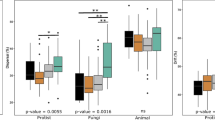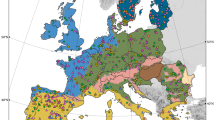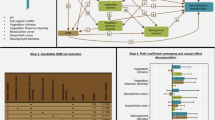Abstract
A central challenge in ecology is to understand the relative importance of processes that shape diversity patterns. Compared with aboveground biota, little is known about spatial patterns and processes in soil organisms. Here we examine the spatial structure of communities of small soil eukaryotes to elucidate the underlying stochastic and deterministic processes in the absence of environmental gradients at a local scale. Specifically, we focus on the fine-scale spatial autocorrelation of prominent taxonomic and functional groups of eukaryotic microbes. We collected 123 soil samples in a nested design at distances ranging from 0.01 to 64 m from three boreal forest sites and used 454 pyrosequencing analysis of Internal Transcribed Spacer for detecting Operational Taxonomic Units of major eukaryotic groups simultaneously. Among the main taxonomic groups, we found significant but weak spatial variability only in the communities of Fungi and Rhizaria. Within Fungi, ectomycorrhizas and pathogens exhibited stronger spatial structure compared with saprotrophs and corresponded to vegetation. For the groups with significant spatial structure, autocorrelation occurred at a very fine scale (<2 m). Both dispersal limitation and environmental selection had a weak effect on communities as reflected in negative or null deviation of communities, which was also supported by multivariate analysis, that is, environment, spatial processes and their shared effects explained on average <10% of variance. Taken together, these results indicate a random distribution of soil eukaryotes with respect to space and environment in the absence of environmental gradients at the local scale, reflecting the dominant role of drift and homogenizing dispersal.
Similar content being viewed by others
Log in or create a free account to read this content
Gain free access to this article, as well as selected content from this journal and more on nature.com
or
Accession codes
References
Astorga A, Oksanen J, Luoto M, Soininen J, Virtanen R, Muotka T . (2012). Distance decay of similarity in freshwater communities: do macro‐and microorganisms follow the same rules? Glob Ecol Biogeogr 21: 365–375.
Bahram M, Põlme S, Kõljalg U, Tedersoo L . (2011). A single European aspen (Populus tremula tree individual may potentially harbour dozens of Cenococcum geophilum ITS genotypes and hundreds of species of ectomycorrhizal fungi. FEMS Microbiol Ecol 75: 313–320.
Bahram M, Koljalg U, Courty P, Diedhiou AG, Kjøller R, Polme S et al. (2013). The distance decay of similarity in communities of ectomycorrhizal fungi in different ecosystems and scales. J Ecol 101: 1335–1344.
Baldrian P, Merhautová V, Cajthaml T, Petránková M, Šnajdr J . (2010). Small-scale distribution of extracellular enzymes, fungal, and bacterial biomass in Quercus petraea forest topsoil. Biol Fertil Soils 46: 717–726.
Baselga A . (2010). Partitioning the turnover and nestedness components of beta diversity. Glob Ecol Biogeogr 19: 134–143.
Bates ST, Clemente JC, Flores GE, Walters WA, Parfrey LW, Knight R et al. (2013). Global biogeography of highly diverse protistan communities in soil. ISME J 7: 652–659.
Bengtsson‐Palme J, Ryberg M, Hartmann M, Branco S, Wang Z, Godhe A et al. (2013). Improved software detection and extraction of ITS1 and ITS2 from ribosomal ITS sequences of fungi and other eukaryotes for analysis of environmental sequencing data. Methods Ecol Evol 4: 914–919.
Bever JD, Richardson SC, Lawrence BM, Holmes J, Watson M . (2009). Preferential allocation to beneficial symbiont with spatial structure maintains mycorrhizal mutualism. Ecol Lett 12: 13–21.
Bie T, Meester L, Brendonck L, Martens K, Goddeeris B, Ercken D et al. (2012). Body size and dispersal mode as key traits determining metacommunity structure of aquatic organisms. Ecol Lett 15: 740–747.
Borcard D, Legendre P . (2002). All-scale spatial analysis of ecological data by means of principal coordinates of neighbour matrices. Ecol Model 153: 51–68.
Bragg L, Stone G, Imelfort M, Hugenholtz P, Tyson GW . (2012). Fast, accurate error-correction of amplicon pyrosequences using acacia. Nat Methods 9: 425–426.
Canham CD, LePage PT, Coates KD . (2004). A neighborhood analysis of canopy tree competition: effects of shading versus crowding. Can J Forest Res 34: 778–787.
Chase JM, Kraft NJB, Smith KG, Vellend M, Inouye BD . (2011). Using null models to disentangle variation in community dissimilarity from variation in α-diversity. Ecosphere 2: 1–11.
Chase JM . (2014). Spatial scale resolves the niche versus neutral theory debate. J Veg Sci 25: 319–322.
Chase JM, Leibold MA . (2003) Ecological Niches: Linking Classical and Contemporary Approaches. University of Chicago Press: : Chicago, IL, USA.
Chave J . (2004). Neutral theory and community ecology. Ecol Lett 7: 241–253.
Condit R, Pitman N, Leigh EG Jr, Chave J, Terborgh J, Foster RB et al. (2002). Beta-diversity in tropical forest trees. Science 295: 666–669.
Cottenie K . (2005). Integrating environmental and spatial processes in ecological community dynamics. Ecol Lett 8: 1175–1182.
Deagle BE, Jarman SN, Coissac E, Pompanon F, Taberlet P . (2014). DNA metabarcoding and the cytochrome c oxidase subunit I marker: not a perfect match. Biol Lett 10: 20140562.
Douhan GW, Vincenot L, Gryta H, Selosse MA . (2011). Population genetics of ectomycorrhizal fungi: from current knowledge to emerging directions. Fungal Biol 115: 569–597.
Dumbrell AJ, Nelson M, Helgason T, Dytham C, Fitter AH . (2010). Relative roles of niche and neutral processes in structuring a soil microbial community. ISME J 4: 337–345.
Edgar RC, Haas BJ, Clemente J C, Quince C, Knight R . (2011). UCHIME improves sensitivity and speed of chimera detection. Bioinformatics 27: 2194–2200.
Esteban GF, Clarke KJ, Olmo JL, Finlay BJ . (2006). Soil protozoa—an intensive study of population dynamics and community structure in an upland grassland. Appl Soil Ecol 33: 137–151.
Ettema CH, Wardle DA . (2002). Spatial soil ecology. Trends Ecol Evol 17: 177–183.
Farjalla VF, Srivastava DS, Marino NAC, Azevedo FD, Dib V, Lopes PM et al. (2012). Ecological determinism increases with organism size. Ecology 93: 1752–1759.
Finlay BJ . (2002). Global dispersal of free-living microbial eukaryote species. Science 296: 1061–1063.
Franklin RB, Mills AL . (2003). Multi‐scale variation in spatial heterogeneity for microbial community structure in an eastern Virginia agricultural field. FEMS Microbiol Ecol 44: 335–346.
Fu L, Niu B, Zhu Z, Wu S, Li W . (2012). CD-HIT: accelerated for clustering the next-generation sequencing data. Bioinformatics 28: 3150–3152.
Gómez‐Aparicio L, Ibánez B, Serrano MS, De Vita P, Avila JM, Pérez‐Ramos IM et al. (2012). Spatial patterns of soil pathogens in declining Mediterranean forests: implications for tree species regeneration. New Phytol 194: 1014–1024.
Green JL, Holmes AJ, Westoby M, Oliver I, Briscoe D, Dangerfield M et al. (2004). Spatial scaling of microbial eukaryote diversity. Nature 432: 747–750.
Hájek M, Roleček J, Cottenie K, Kintrová K, Horsák M, Poulíčková A et al. (2011). Environmental and spatial controls of biotic assemblages in a discrete semi‐terrestrial habitat: comparison of organisms with different dispersal abilities sampled in the same plots. J Biogeogr 38: 1683–1693.
Hanson CA, Fuhrman JA, Horner-Devine MC, Martiny JB . (2012). Beyond biogeographic patterns: processes shaping the microbial landscape. Nat Rev Microbiol 10: 497–506.
Hubbell SP . (2001) The Unified Neutral Theory of Biodiversity and Biogeography. Princeton University Press: : Princeton, NJ, USA.
Kerr B, Neuhauser C, Bohannan BJ, Dean AM . (2006). Local migration promotes competitive restraint in a host–pathogen 'tragedy of the commons'. Nature 442: 75–78.
Lara E, Heger TJ, Scheihing R, Mitchell EA . (2011). COI gene and ecological data suggest size-dependent high dispersal and low intra-specific diversity in free-living terrestrial protists (Euglyphida: Assulina). J Biogeogr 38: 640–650.
Lauber CL, Hamady M, Knight R, Fierer N . (2009). Pyrosequencing-based assessment of soil pH as a predictor of soil bacterial community structure at the continental scale. Appl Environ Microbiol 75: 5111–5120.
Legendre P, Mi X, Ren H, Ma K, Yu M, Sun I et al. (2009). Partitioning beta diversity in a subtropical broad-leaved forest of China. Ecology 90: 663–674.
Lekberg Y, Koide R T, Rohr J R, Aldrich‐Wolfe L, Morton JB . (2007). Role of niche restrictions and dispersal in the composition of arbuscular mycorrhizal fungal communities. J Ecol 95: 95–105.
Liang W, Jiang Y, Li Q, Liu Y, Wen D . (2005). Spatial distribution of bacterivorous nematodes in a Chinese Ecosystem Research Network (CERN) site. Ecol Res 20: 481–486.
Lindahl BD, Ihrmark K, Boberg J, Trumbore SE, Hogberg P, Stenlid J et al. (2007). Spatial separation of litter decomposition and mycorrhizal nitrogen uptake in a boreal forest. New Phytol 173: 611–620.
Lowe WH, McPeek MA . (2014). Is dispersal neutral? Trends Ecol Evol 29: 444–450.
Martiny JB, Eisen JA, Penn K, Allison SD, Horner-Devine MC . (2011). Drivers of bacterial beta-diversity depend on spatial scale. Proc Natl Acad Sci USA 108: 7850–7854.
Morlon H, Chuyong G, Condit R, Hubbell S, Kenfack D, Thomas D et al. (2008). A general framework for the distance–decay of similarity in ecological communities. Ecol Lett 11: 904–917.
Nekola JC, White PS . (1999). The distance decay of similarity in biogeography and ecology. J Biogeogr 26: 867–878.
Oksanen J, Blanchet FG, Kindt R, Legendre P, Minchin PR, O’Hara R et al. (2013). Package ‘vegan’.
Pärtel M, Laanisto L, Wilson SD . (2008). Soil nitrogen and carbon heterogeneity in woodlands and grasslands: contrasts between temperate and tropical regions. Glob Ecol Biogeogr 17: 18–24.
Petersen H, Luxton M . (1982). A comparative analysis of soil fauna populations and their role in decomposition processes. Oikos 39: 288–388.
Plett JM, Martin F . (2011). Blurred boundaries: lifestyle lessons from ectomycorrhizal fungal genomes. Trends Genet 27: 14–22.
Porco D, Potapov M, Bedos A, Busmachiu G, Weiner WM, Hamra-Kroua S et al. (2012). Cryptic diversity in the ubiquist species Parisotoma notabilis (Collembola, Isotomidae): a long-used chimeric species? PLoS One 7: e46056.
Poulin R . (2003). The decay of similarity with geographical distance in parasite communities of vertebrate hosts. J Biogeogr 30: 1609–1615.
Queloz V, Sieber TN, Holdenrieder O, McDonald BA, Grünig C R . (2011). No biogeographical pattern for a root‐associated fungal species complex. Glob Ecol Biogeogr 20: 160–169.
R Development Core Team (2007). R: A Language and Environment for Statistical Computing. R.F.f.S. Computing: Vienna, Austria.
Ritz K, McNicol J, Nunan N, Grayston S, Millard P, Atkinson D et al. (2004). Spatial structure in soil chemical and microbiological properties in an upland grassland. FEMS Microbiol Ecol 49: 191–205.
Robeson MS, King AJ, Freeman KR, Birky CW Jr, Martin AP, Schmidt SK . (2011). Soil rotifer communities are extremely diverse globally but spatially autocorrelated locally. Proc Natl Acad Sci USA 108: 4406–4410.
Rousk J, Bååth E, Brookes PC, Lauber CL, Lozupone C, Caporaso JG et al. (2010). Soil bacterial and fungal communities across a pH gradient in an arable soil. ISME J 4: 1340–1351.
Schloss PD, Westcott SL, Ryabin T, Hall JR, Hartmann M, Hollister EB et al. (2009). Introducing mothur: open-source, platform-independent, community-supported software for describing and comparing microbial communities. Appl Environ Microbiol 75: 7537–7541.
Soininen J, McDonald R, Hillebrand H . (2007). The distance decay of similarity in ecological communities. Ecography 30: 3–12.
Stamatakis A, Hoover P, Rougemont J . (2008). A rapid bootstrap algorithm for the RAxML web servers. Syst Biol 57: 758–771.
Stegen JC, Lin X, Fredrickson J K, Chen X, Kennedy DW, Murray CJ et al. (2013). Quantifying community assembly processes and identifying features that impose them. ISME J 7: 2069–2079.
Steinbauer MJ, Dolos K, Reineking B, Beierkuhnlein C . (2012). Current measures for distance decay in similarity of species composition are influenced by study extent and grain size. Glob Ecol Biogeogr 21: 1203–1212.
Štursová M, Baldrian P . (2011). Effects of soil properties and management on the activity of soil organic matter transforming enzymes and the quantification of soil-bound and free activity. Plant Soil 338: 99–110.
Talbot JM, Bruns TD, Taylor JW, Smith DP, Branco S, Glassman SI et al. (2014). Endemism and functional convergence across the North American soil mycobiome. Proc Natl Acad Sci USA 111: 6341–6346.
Tedersoo L, Bahram M, Cajthaml T, Põlme S, Hiiesalu I, Anslan S et al. (2015). Tree diversity and species identity effects on soil fungi, protists and animals are context-dependent. ISME J e-pub ahead of print 14 July 2015 doi:10.1038/ismej.2015.116.
Tedersoo L, Bahram M, Põlme S, Kõljalg U, Yorou NS, Wijesundera R et al. (2014). Global diversity and geography of soil fungi. Science 346: 1256688.
Tedersoo L, Nilsson RH, Abarenkov K, Jairus T, Sadam A, Saar I et al. (2010). 454 pyrosequencing and sanger sequencing of tropical mycorrhizal fungi provide similar results but reveal substantial methodological biases. New Phytol 188: 291–301.
Tedersoo L, Smith ME . (2013). Lineages of ectomycorrhizal fungi revisited: foraging strategies and novel lineages revealed by sequences from belowground. Fungal Biol Rev 27: 83–99.
Tedersoo L, Naadel T, Bahram M, Pritsch K, Buegger F, Leal M et al. (2012). Enzymatic activities and stable isotope patterns of ectomycorrhizal fungi in relation to phylogeny and exploration types in an afrotropical rain forest. New Phytol 195: 832–843.
Vellend M . (2010). Conceptual synthesis in community ecology. Q Rev Biol 85: 183–206.
Vellend M, Srivastava DS, Anderson KM, Brown CD, Jankowski JE, Kleynhans EJ et al. (2014). Assessing the relative importance of neutral stochasticity in ecological communities. Oikos 123: 1420–1430.
Wang J, Shen J, Wu Y, Tu C, Soininen J, Stegen JC et al. (2013). Phylogenetic beta diversity in bacterial assemblages across ecosystems: deterministic versus stochastic processes. ISME J 7: 1310–1321.
Wardle DA . (2002) Communities and Ecosystems: Linking the Aboveground and Belowground Components. Princeton University Press: : Princeton, NJ, USA.
Warren DL, Cardillo M, Rosauer DF, Bolnick DI . (2014). Mistaking geography for biology: inferring processes from species distributions. Trends Ecol Evol 29: 572–580.
Wu T, Ayres E, Bardgett RD, Wall DH, Garey JR . (2011). Molecular study of worldwide distribution and diversity of soil animals. Proc Natl Acad Sci USA 108: 17720–17725.
Zhou J, Xia B, Huang H, Palumbo AV, Tiedje JM . (2004). Microbial diversity and heterogeneity in sandy subsurface soils. Appl Environ Microbiol 70: 1723–1734.
Acknowledgements
We thank M Mett for help during field sampling. M Nõukas and R Puusepp for sample preparation. We also thank Ari Jumpponen and five anonymous referees for their constructive comments on the earlier version of this manuscript. This study was funded by ESF grant nos. 9286, PUT0171, NPUI LO1417 MSMT and FIBIR.
Author information
Authors and Affiliations
Corresponding author
Ethics declarations
Competing interests
The authors declare no conflict of interest.
Additional information
Supplementary Information accompanies this paper on The ISME Journal website
Supplementary information
Rights and permissions
About this article
Cite this article
Bahram, M., Kohout, P., Anslan, S. et al. Stochastic distribution of small soil eukaryotes resulting from high dispersal and drift in a local environment. ISME J 10, 885–896 (2016). https://doi.org/10.1038/ismej.2015.164
Received:
Revised:
Accepted:
Published:
Issue date:
DOI: https://doi.org/10.1038/ismej.2015.164
This article is cited by
-
Gravesoil fungi are more sensitive than bacteria in response to precipitation
Soil Ecology Letters (2024)
-
Unraveling the relationship between plant species and physicochemical properties on rhizosphere and rhizoplane fungal communities in alpine wet meadows
Environmental Sciences Europe (2023)
-
Deterministic Processes Shape Abundant and Rare Bacterial Communities in Drinking Water
Current Microbiology (2023)
-
Phosphorus amendment alters soil arbuscular mycorrhizal fungal functional guild compositions in a subtropical forest
Journal of Soils and Sediments (2023)
-
Stochastic processes dominate assembly of soil fungal community in grazing excluded grasslands in northwestern China
Journal of Soils and Sediments (2023)



